France: Modèle 1914 Equipment d'Infanterie de Sangles
Haversacks & Packs
HAVERSACK
MUSETTE
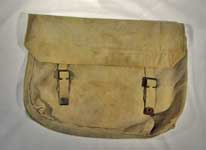
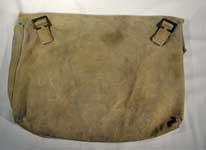 In the 43e Regiment photo, the old standard canvas Haversacks (musettes), in two colours, are being carried on slings. However, the “V” attachment allows the Brace ends to hang below the Belt, though there are only three ends. A front left end, plus the rear carry the web Haversack (left), which has wide-set and angled buckles and chapes to suit. This places it more over the left buttock usually, which was its typical position, not at the side.
In the 43e Regiment photo, the old standard canvas Haversacks (musettes), in two colours, are being carried on slings. However, the “V” attachment allows the Brace ends to hang below the Belt, though there are only three ends. A front left end, plus the rear carry the web Haversack (left), which has wide-set and angled buckles and chapes to suit. This places it more over the left buttock usually, which was its typical position, not at the side.
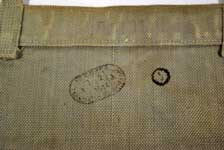 Stamping detail from the inner side of the flap. Typically French in shape and size, but unfortunately, all we have been able to decipher is the date - 1914. All photos this section are from the Simon Braillon Collection. Photographs © Simon Braillon 2010.
Stamping detail from the inner side of the flap. Typically French in shape and size, but unfortunately, all we have been able to decipher is the date - 1914. All photos this section are from the Simon Braillon Collection. Photographs © Simon Braillon 2010.
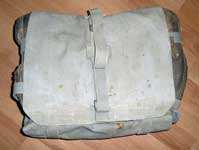
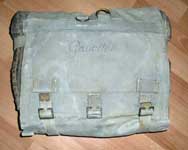
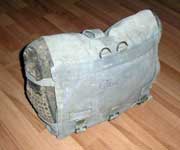 The Rucksack is supported on reduction woven straps, like the Braces, the narrow ends attaching to a pair of metal loops, set close together on the rear face. The straps are absent on this example, so they may have been stitched round the loops, or be removable. A full depth flap is secured by two 1-inch straps, which secure to buckles above the lower edge of the reverse face – where they would no doubt dig into the wearer’s back, augmented by a third buckle for the long, vertical load strap that typefies the leather M-1893 Rucksack. The location of these buckles is another point against Mills practice. Thoughtfully, fixed loops are positioned above the flap strap buckles, to tidy away the running ends.
The Rucksack is supported on reduction woven straps, like the Braces, the narrow ends attaching to a pair of metal loops, set close together on the rear face. The straps are absent on this example, so they may have been stitched round the loops, or be removable. A full depth flap is secured by two 1-inch straps, which secure to buckles above the lower edge of the reverse face – where they would no doubt dig into the wearer’s back, augmented by a third buckle for the long, vertical load strap that typefies the leather M-1893 Rucksack. The location of these buckles is another point against Mills practice. Thoughtfully, fixed loops are positioned above the flap strap buckles, to tidy away the running ends.
The M-1893 Rucksack was nicknamed As de Carreau (Ace of Diamonds – why?), or L’azor de troupier, shortened to Azor, by Les Poilus (The Hairy Ones). It was typical of such box knapsacks in having laterally buckled flaps under the full-depth main flap. The Mle 1914 Rucksack is therefore a surprising arrangement, oweing more to the U.S. M-1910 Haversack – a misnomer for what we would term a Rucksack, or Pack.
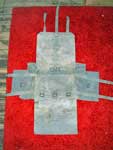
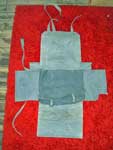 The French version opens up completely flat, a single piece of fabric forming lower front flap, base and back of the Rucksack. A second piece of fabric is stitched to the upper edge, forming the top and upper flap. An external full-width, reinforcing strip of 1-inch webbing is stitched over the join. The section forming the true rear face has secondary, transverse flaps stitched to each edge. These are heavily hemmed on the outside, such that there is a distinctive vertical flange. At their upper edges, additional material is stitched to form weather flaps. Each of these secondary flaps has a chape with brass loop, positioned just in from where the side flap transitions from “side” to “front”. The links are too far apart to connect directly to each other, though both are the same size of 1-inch strap accomodation. Perhaps a separate strap was provided to pull the side flaps securely together. When the upper flap is closed, these brass loops are under the flap, so do not appear to be anchorages for blanket straps.
The French version opens up completely flat, a single piece of fabric forming lower front flap, base and back of the Rucksack. A second piece of fabric is stitched to the upper edge, forming the top and upper flap. An external full-width, reinforcing strip of 1-inch webbing is stitched over the join. The section forming the true rear face has secondary, transverse flaps stitched to each edge. These are heavily hemmed on the outside, such that there is a distinctive vertical flange. At their upper edges, additional material is stitched to form weather flaps. Each of these secondary flaps has a chape with brass loop, positioned just in from where the side flap transitions from “side” to “front”. The links are too far apart to connect directly to each other, though both are the same size of 1-inch strap accomodation. Perhaps a separate strap was provided to pull the side flaps securely together. When the upper flap is closed, these brass loops are under the flap, so do not appear to be anchorages for blanket straps.
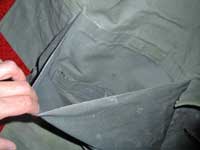
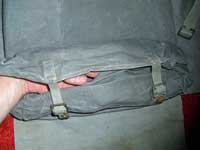 Internally, a piece of thin cotton duck forms a full depth and full width pocket on the rear face. At the bottom of this and superimposed in front, a second full width pocket is fitted. This is about 4-inches in depth and extends out from the back wall to fill the “base” of the Rucksack. It is closed by a cotton duck box-lid, secured by a pair of ½-inch web straps and buckles. It rather foreshadows the Lower rucksack of South African Braithwaite Pattern and was perhaps for Necessaries (mess irons, toilet kit, holdall type items) in British Army parlance. A pair of blanket greatcoat straps, 1-inch wide, is stitched into each vertical, rear edge, with buckles on the right. These served to also hold a spare pair of boots and fastened under the upper flap, not as with those on the Upper rucksack of Patt. ’25. On the outside, rear face (i.e. next to the wearer’s back, a pair of semi-circular brass dees are stitched on chapes behind the reinforcing strip. These had shouder straps attached, but whether these were detachable, or have simply been cut-off is not established.
Internally, a piece of thin cotton duck forms a full depth and full width pocket on the rear face. At the bottom of this and superimposed in front, a second full width pocket is fitted. This is about 4-inches in depth and extends out from the back wall to fill the “base” of the Rucksack. It is closed by a cotton duck box-lid, secured by a pair of ½-inch web straps and buckles. It rather foreshadows the Lower rucksack of South African Braithwaite Pattern and was perhaps for Necessaries (mess irons, toilet kit, holdall type items) in British Army parlance. A pair of blanket greatcoat straps, 1-inch wide, is stitched into each vertical, rear edge, with buckles on the right. These served to also hold a spare pair of boots and fastened under the upper flap, not as with those on the Upper rucksack of Patt. ’25. On the outside, rear face (i.e. next to the wearer’s back, a pair of semi-circular brass dees are stitched on chapes behind the reinforcing strip. These had shouder straps attached, but whether these were detachable, or have simply been cut-off is not established.
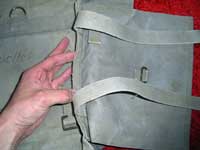
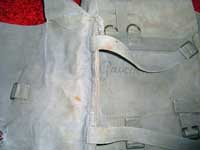
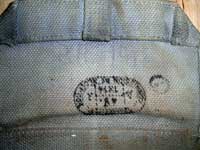 Along the lower part of the rear face are three 1-inch buckles, the outer ones having a fixed web loop above. These secure the upper flap, the central buckle being used for the long load strap. All three buckles are positioned to dig into the wearer’s back – not too clever. Stitched to the lower main flap, on its “base” section are a chape and semi-circular brass dee, one each side. These are anchor points for the counter strap, either by buckling, or hook on an adjustable loop. One chape and loop are missing on this example, but this may have been a buckle. It was common European practice to have one side buckled, the other hooked, for ease of putting on a Rucksack. This was replicated in Patt. ’19 Rucksacks. A long load strap is stitched between the attachment dees for the shoulder straps. On the example illustrated, it has been tidied, first downwards through the central flap loop and a buckle near the lower edge of the upper flap. From there it has been passed back up through the central loop, up through a loop on the upper front edge and back down and under the central loop. Apart from rolled blanket or greatcoat, horseshoe fashion around the Rucksack, this held the individual mess tin and one or other of the boilers, or 8-man mess tins, according to how they had been divided up amongst the soldiers.
Along the lower part of the rear face are three 1-inch buckles, the outer ones having a fixed web loop above. These secure the upper flap, the central buckle being used for the long load strap. All three buckles are positioned to dig into the wearer’s back – not too clever. Stitched to the lower main flap, on its “base” section are a chape and semi-circular brass dee, one each side. These are anchor points for the counter strap, either by buckling, or hook on an adjustable loop. One chape and loop are missing on this example, but this may have been a buckle. It was common European practice to have one side buckled, the other hooked, for ease of putting on a Rucksack. This was replicated in Patt. ’19 Rucksacks. A long load strap is stitched between the attachment dees for the shoulder straps. On the example illustrated, it has been tidied, first downwards through the central flap loop and a buckle near the lower edge of the upper flap. From there it has been passed back up through the central loop, up through a loop on the upper front edge and back down and under the central loop. Apart from rolled blanket or greatcoat, horseshoe fashion around the Rucksack, this held the individual mess tin and one or other of the boilers, or 8-man mess tins, according to how they had been divided up amongst the soldiers.
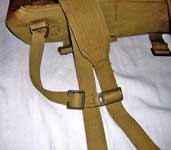
 The leather M1893 Rucksack had two piece shoulder straps, a broad shoulder flare and a narrower, under-arm counter strap loosely rivetted to the broad strap. The illustration of this Rucksack at left is from Sac Au Dos, by Commandant Emile Charles Lavisse (Hachette et Cie, Paris, 1902). It is not clear how this was replicated in the webbing form, but
the rear man, second from right, and the one second from left, both have some kind of metal fitting in their left armpits. This might be a component noted in other Mills’ Rucksacks, which is a narrow (top-to-bottom) strap with an eye, or side loop. The photo at right shows a similar strap on another Mills design. This photo is of a Rucksack from the Karkee Web Collection. In such an arrangement, the counter strap is stitched to the eye, with a buckle adjusted loop at its further end, either carrying a hook to attach to a base ring, or attached directly to a base dee and adjustable through it. The M1893 Rucksack straps buckled to the base, which is probably the arrangement here. The missing shoulder straps and unavailability of photos showing the base, makes it impossible to determine what arrangement exists. On the rear view, a web chape is visible at the bottom left-hand corner. The corresponding chape opposite has been cut off. Whatever fitting – loop, or buckle - has been removed.
The leather M1893 Rucksack had two piece shoulder straps, a broad shoulder flare and a narrower, under-arm counter strap loosely rivetted to the broad strap. The illustration of this Rucksack at left is from Sac Au Dos, by Commandant Emile Charles Lavisse (Hachette et Cie, Paris, 1902). It is not clear how this was replicated in the webbing form, but
the rear man, second from right, and the one second from left, both have some kind of metal fitting in their left armpits. This might be a component noted in other Mills’ Rucksacks, which is a narrow (top-to-bottom) strap with an eye, or side loop. The photo at right shows a similar strap on another Mills design. This photo is of a Rucksack from the Karkee Web Collection. In such an arrangement, the counter strap is stitched to the eye, with a buckle adjusted loop at its further end, either carrying a hook to attach to a base ring, or attached directly to a base dee and adjustable through it. The M1893 Rucksack straps buckled to the base, which is probably the arrangement here. The missing shoulder straps and unavailability of photos showing the base, makes it impossible to determine what arrangement exists. On the rear view, a web chape is visible at the bottom left-hand corner. The corresponding chape opposite has been cut off. Whatever fitting – loop, or buckle - has been removed.

 The web loop, at top left of the left transverse flap is not matched on the opposite side. It may be for securing the pelle beche – the entrenching tool of short-handled spade form. What is unusual is the lack of loops / straps on the “top” of the Rucksack, for banket / greatcoat roll, as in the Mle. 1893 type. All Modèle 1914 photos this section are from the Simon Braillon Collection. Photographs © Simon Braillon 2010.
The web loop, at top left of the left transverse flap is not matched on the opposite side. It may be for securing the pelle beche – the entrenching tool of short-handled spade form. What is unusual is the lack of loops / straps on the “top” of the Rucksack, for banket / greatcoat roll, as in the Mle. 1893 type. All Modèle 1914 photos this section are from the Simon Braillon Collection. Photographs © Simon Braillon 2010.
The two photos at left, also from Sac au Dos, show French soldats in full equipment. Note the height to which the equipment is loaded on top of the Rucksack.